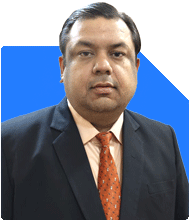Ramalingam Kalirajan |9255 Answers |Ask -Follow
Mutual Funds, Financial Planning Expert - Answered on May 29, 2025
He has an MBA in finance from the University of Madras and is a certified financial planner.
He is the director and chief financial planner at Holistic Investment, a Chennai-based firm that offers financial planning and wealth management advice.... more

Hello sir I'm working in PSU and earning 1.0 lakh per month. I have purchased term plan of 1.00 cr and health insurance policy of 10.00 lakh cover. My savings are 20 lakhs in mutual fund and 10 lakh in shares. I'm 32 years old. I have no emi and currently investing 50k in mutual fund every month . Please review and guide me for wealth building. I have not invested in real estate. Should I invest in real estate and how. Saurabh Tiwari
You are saving Rs.50,000 per month in mutual funds. Very disciplined.
You already have Rs.30 lakhs in mutual funds and shares. That’s significant.
You also have Rs.1 crore term cover and Rs.10 lakh health cover. Very good.
You also have no EMI or loan pressure. That’s a strong financial position.
These things show you are managing your finances well. Appreciate your approach.
Now we will go deeper. Let’s optimise your future wealth creation plan.
You Should Not Invest in Real Estate
You asked if real estate should be part of your portfolio.
Let’s assess this clearly.
Real estate blocks a large amount of capital.
It lacks liquidity. You cannot sell quickly if you need money.
Property requires maintenance, taxes, and legal care.
Rental yield is usually low in India. Around 2 to 3% only.
Also, resale price depends on market cycles. Not always predictable.
Real estate brings emotional stress and paperwork also.
At your stage, real estate is not needed.
You already have better-performing investments in mutual funds.
Keep your portfolio simple and flexible.
Your Mutual Fund Investment is a Good Strategy
You invest Rs.50,000 monthly in mutual funds. That’s a strong move.
Mutual funds give better flexibility and transparency.
You can start, stop, increase or decrease anytime.
There is professional fund management involved.
They manage risk and returns with experience.
You must invest only in actively managed mutual funds.
Do not invest in index funds.
Index funds only copy the index. No research involved.
They cannot react to market changes actively.
They give average returns, not superior performance.
You must avoid index funds for wealth creation.
Actively managed funds adjust based on market signals.
They aim to beat the market, not just copy it.
Stay with actively managed funds only.
Don’t Invest in Direct Funds
Direct mutual funds may look cheaper. But they lack guidance.
You invest without personalised advice in direct plans.
No expert is there to guide rebalancing or review.
Many investors pick wrong funds in direct mode.
They also redeem early due to fear.
Regular plan via Certified Financial Planner gives peace and structure.
It includes risk profiling, goal matching and review sessions.
This helps you stay disciplined and focused.
Even fund selection is better aligned to your goals.
Stick to regular funds with guidance.
Don’t chase small savings by going direct.
Review the Structure of Your Portfolio
You already have Rs.20 lakhs in mutual funds.
And Rs.10 lakhs in direct shares.
Let’s structure this better now.
Split your overall goals into short, mid, and long-term buckets.
Each goal must have a separate investment plan.
Short-term goal (1-2 years) needs liquid and low-risk funds.
Mid-term goals (3-5 years) need hybrid or balanced funds.
Long-term goals (7+ years) need good quality equity funds.
This kind of bucket structure gives clarity and peace.
Also helps in managing your asset allocation better.
Your Direct Equity Holding Needs Assessment
You have Rs.10 lakhs in stocks. That’s a good size.
But individual shares carry high risk.
Unless you have time and skill, this can be dangerous.
One poor choice can affect overall return.
Mutual funds reduce this risk with diversification and expert handling.
If you are managing shares yourself, check past returns.
If returns are not beating mutual funds, shift some to funds.
Also avoid overexposure to few companies or sectors.
Diversification is not optional. It is safety.
Don’t exceed 20-25% of portfolio in direct stocks.
Keep the rest in mutual funds for stability.
Build an Emergency Fund if Not Already Done
You did not mention emergency fund in your note.
This is a must before all investments.
Keep at least 6 months of expenses aside.
For you, that may be Rs.6 to 7 lakhs.
Use liquid funds or sweep-in FDs.
This protects against job loss or medical event.
This should not be mixed with investment portfolio.
Keep it separate and untouched.
Stay Away from Fancy or Trendy Investments
Avoid crypto or other unregulated products.
These may sound attractive but are risky.
Your current approach is working well.
Stick to what is tested and consistent.
Wealth creation is not about thrill. It is about structure.
Focus on long-term strategy, not temporary fads.
Track and Review Portfolio Annually
You are already investing regularly.
But don’t forget review is also key.
At least once a year, check if all goals are on track.
Check if fund performance is aligned to benchmark.
Review asset allocation—debt vs equity.
Also match your progress with life goals.
Adjust SIP amounts if income has increased.
This gives more power to your plan.
Do Not Increase Lifestyle Expenses Unnecessarily
You don’t have EMI burden. That’s good.
But avoid the trap of lifestyle inflation.
Don’t increase your spending just because salary increases.
Use that extra income to invest more.
Increase SIP every year with salary growth.
This step alone can build huge wealth.
It’s called SIP step-up strategy. Very powerful.
Think About Retirement Planning Actively
You are just 32 now. Retirement looks far.
But this is the best time to build retirement fund.
Time is your biggest strength today.
Even small SIP now becomes big later.
Start a separate SIP only for retirement.
Don’t mix it with other goals.
Keep investing in equity mutual funds for this.
You can also use top-up SIP feature for this.
Let this fund run for next 25-30 years.
It will take care of your future freedom.
Be Mindful of Taxation on Mutual Funds
Tax rules are changing now.
LTCG on equity funds above Rs.1.25 lakh is taxed at 12.5%.
STCG on equity funds is taxed at 20%.
Debt mutual funds are taxed as per your income slab.
So, avoid frequent switching and redeeming.
Stay long term to reduce tax impact.
Also track capital gains each year for filing.
Tax planning is also part of wealth building.
Avoid Buying ULIPs or Traditional Insurance Plans
You did not mention holding ULIPs. That’s good.
Don’t mix insurance and investment.
ULIPs and endowment plans give low return.
They also have high charges and long lock-in.
Better to keep term insurance and mutual funds separate.
If anyone offers such combo products, say no.
Use Certified Financial Planner for 360-Degree View
Your portfolio is large now.
A Certified Financial Planner can help manage this better.
They help align all goals—retirement, child future, home, travel.
They also provide review, rebalancing, taxation, insurance planning.
This support improves your peace and clarity.
Don't rely on tips or friends' advice.
Certified professionals offer structured and tested solutions.
You already have strong base. Now move to structured approach.
Finally
Your financial journey is on a very good path.
You have high savings, no debt, and strong discipline.
You also took right steps with insurance.
Now avoid real estate investment. It’s not needed.
Stick with mutual funds, avoid index and direct funds.
Review equity stocks. Don’t exceed 25% exposure.
Use a proper goal-based approach for each investment.
Avoid lifestyle creep. Step-up your SIP yearly.
Add a dedicated retirement fund.
Track taxes and review portfolio yearly.
Get help from Certified Financial Planner for better alignment.
You are already ahead of most. Keep this momentum going.
Your wealth will grow safely and strongly with this direction.
Best Regards,
K. Ramalingam, MBA, CFP,
Chief Financial Planner,
www.holisticinvestment.in
https://www.youtube.com/@HolisticInvestment
आप नीचे ऐसेही प्रश्न और उत्तर देखना पसंद कर सकते हैं
Ramalingam Kalirajan |9255 Answers |Ask -Follow
Mutual Funds, Financial Planning Expert - Answered on Apr 17, 2024
Ramalingam Kalirajan |9255 Answers |Ask -Follow
Mutual Funds, Financial Planning Expert - Answered on Jul 29, 2024
Ramalingam Kalirajan |9255 Answers |Ask -Follow
Mutual Funds, Financial Planning Expert - Answered on Aug 28, 2024
Ramalingam Kalirajan |9255 Answers |Ask -Follow
Mutual Funds, Financial Planning Expert - Answered on Jun 13, 2025
Radheshyam Zanwar |4292 Answers |Ask -Follow
MHT-CET, IIT-JEE, NEET-UG Expert - Answered on Jun 28, 2025
Yogendra Arora |36 Answers |Ask -Follow
Tax Expert - Answered on Jun 28, 2025
Yogendra Arora |36 Answers |Ask -Follow
Tax Expert - Answered on Jun 28, 2025
Radheshyam Zanwar |4292 Answers |Ask -Follow
MHT-CET, IIT-JEE, NEET-UG Expert - Answered on Jun 28, 2025
Radheshyam Zanwar |4292 Answers |Ask -Follow
MHT-CET, IIT-JEE, NEET-UG Expert - Answered on Jun 28, 2025
Dr Nagarajan J S K |1432 Answers |Ask -Follow
NEET, Medical, Pharmacy Careers - Answered on Jun 28, 2025
Dr Nagarajan J S K |1432 Answers |Ask -Follow
NEET, Medical, Pharmacy Careers - Answered on Jun 28, 2025
Dr Nagarajan J S K |1432 Answers |Ask -Follow
NEET, Medical, Pharmacy Careers - Answered on Jun 28, 2025
Dr Nagarajan J S K |1432 Answers |Ask -Follow
NEET, Medical, Pharmacy Careers - Answered on Jun 28, 2025
Dr Nagarajan J S K |1432 Answers |Ask -Follow
NEET, Medical, Pharmacy Careers - Answered on Jun 28, 2025





















